Appendicitis
18-year old female presented in ER with complaint of right sided abdominal pain for two days associated with fever, vomiting, and diarrhea.
Clinical History
18-year old female presented in ER with complaint ofright sided abdominal pain for two days associated with fever, vomiting, and diarrhea.
CT Findings
Appendix is enlarged with small appendicolith and surrounded by fat stranding and some fluid with thickening of adjacent bowel loops represent appendicitis with possible perforation.
Pathology
Acute perforated suppurative appendicitis and periappendicitis.

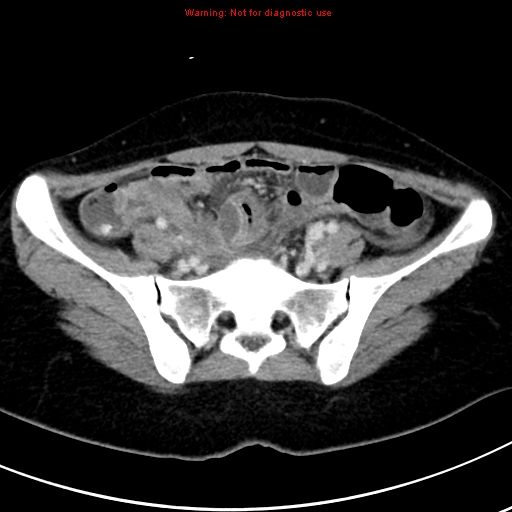
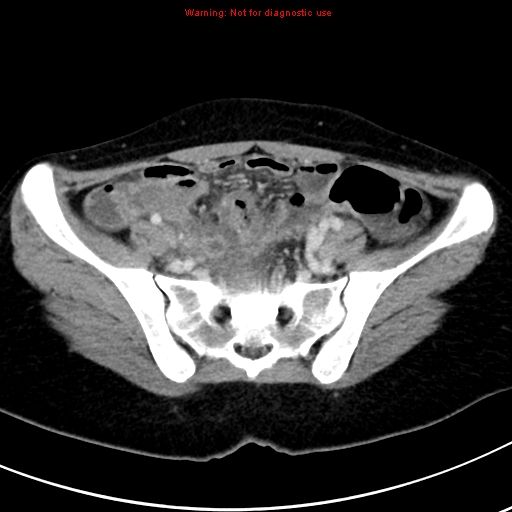
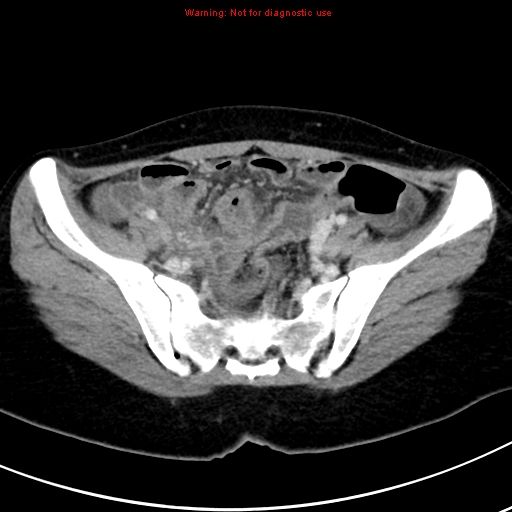
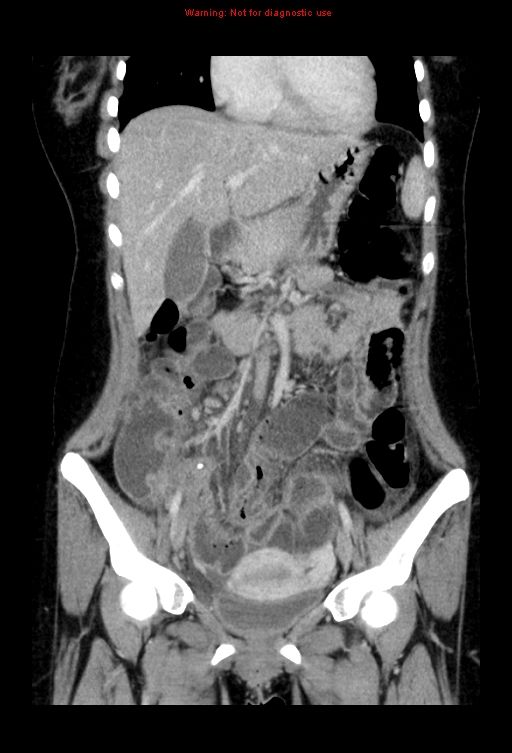
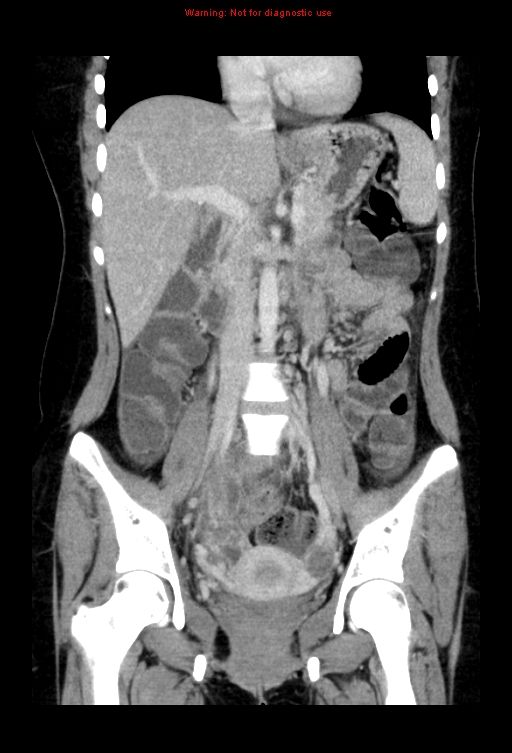
Background
Appendicitis is defined as an inflammation of the inner lining of the vermiform appendix that spreads to its other parts. This condition is a common and urgent surgical illness with protean manifestations, generous overlap with other clinical syndromes, and significant morbidity, which increases with diagnostic delay. In fact, despite diagnostic and therapeutic advancement in medicine, appendicitis remains a clinical emergency and is one of the more common causes of acute abdominal pain.
No single sign, symptom, or diagnostic test accurately confirms the diagnosis of appendiceal inflammation in all cases, and the classic history of anorexia and periumbilical pain followed by nausea, right lower quadrant (RLQ) pain, and vomiting occurs in only 50 percent of cases.
Appendicitis may occur for several reasons, such as an infection of the appendix, but the most important factor is the obstruction of the appendiceal lumen. Left untreated, appendicitis has the potential for severe complications, including perforation or sepsis, and may even cause death. However, the differential diagnosis of appendicitis is often a clinical challenge because appendicitis can mimic several abdominal conditions.
Appendectomy remains the only curative treatment of appendicitis (see Treatment and Management). The surgeon's goals are to evaluate a relatively small population of patients referred for suspected appendicitis and to minimize the negative appendectomy rate without increasing the incidence of perforation. The emergency department (ED) clinician must evaluate the larger group of patients who present to the ED with abdominal pain of all etiologies with the goal of approaching 100 percent sensitivity for the diagnosis in a time-, cost-, and consultation-efficient manner.
Etiology
Appendicitis is caused by obstruction of the appendiceal lumen. The most common causes of luminal obstruction include lymphoid hyperplasia secondary to inflammatory bowel disease (IBD) or infections (more common during childhood and in young adults), fecal stasis and fecaliths (more common in elderly patients), parasites (especially in Eastern countries), or, more rarely, foreign bodies and neoplasms.
Fecaliths form when calcium salts and fecal debris become layered around a nidus of inspissated fecal material located within the appendix. Lymphoid hyperplasia is associated with various inflammatory and infectious disorders including Crohn disease, gastroenteritis, amebiasis, respiratory infections, measles, and mononucleosis.
Obstruction of the appendiceal lumen has less commonly been associated with bacteria (Yersinia species, adenovirus, cytomegalovirus, actinomycosis, Mycobacteria species, Histoplasma species), parasites (eg, Schistosomes species, pinworms, Strongyloides stercoralis), foreign material (eg, shotgun pellet, intrauterine device, tongue stud, activated charcoal), tuberculosis, and tumors.
Stages of Appendicitis
The stages of appendicitis can be divided into early, suppurative, gangrenous, perforated, phlegmonous, spontaneous resolving, recurrent, and chronic.
Early stage appendicitis - In the early stage of appendicitis, obstruction of the appendiceal lumen leads to mucosal edema, mucosal ulceration, bacterial diapedesis, appendiceal distention due to accumulated fluid, and increasing intraluminal pressure. The visceral afferent nerve fibers are stimulated, and the patient perceives mild visceral periumbilical or epigastric pain, which usually lasts four to six hours.
Suppurative appendicitis - Increasing intraluminal pressures eventually exceed capillary perfusion pressure, which is associated with obstructed lymphatic and venous drainage and allows bacterial and inflammatory fluid invasion of the tense appendiceal wall. Transmural spread of bacteria causes acute suppurative appendicitis. When the inflamed serosa of the appendix comes in contact with the parietal peritoneum, patients typically experience the classic shift of pain from the periumbilicus to the right lower abdominal quadrant (RLQ), which is continuous and more severe than the early visceral pain.
Gangrenous appendicitis - Intramural venous and arterial thromboses ensue, resulting in gangrenous appendicitis.
Perforated appendicitis - Persisting tissue ischemia results in appendiceal infarction and perforation. Perforation can cause localized or generalized peritonitis.
Phlegmonous appendicitis or abscess - An inflamed or perforated appendix can be walled off by the adjacent greater omentum or small-bowel loops, resulting in phlegmonous appendicitis or focal abscess.
Spontaneously resolving appendicitis - If the obstruction of the appendiceal lumen is relieved, acute appendicitis may resolve spontaneously. This occurs if the cause of the symptoms is lymphoid hyperplasia or when a fecalith is expelled from the lumen.
Recurrent appendicitis - The incidence of recurrent appendicitis is 10 percent. The diagnosis is accepted as such if the patient underwent similar occurrences of RLQ pain at different times that, after appendectomy, were histopathologically proven to be the result of an inflamed appendix.
Chronic appendicitis - Chronic appendicitis occurs with an incidence of 1 percent and is defined by the following: (1) the patient has a history of RLQ pain of at least three weeks’ duration without an alternative diagnosis; (2) after appendectomy, the patient experiences complete relief of symptoms; (3) histopathologically, the symptoms were proven to be the result of chronic active inflammation of the appendiceal wall or fibrosis of the appendix.
Diagnostic Considerations
The overall accuracy for diagnosing acute appendicitis is approximately 80 percent, which corresponds to a mean false-negative appendectomy rate of 20 percent. Diagnostic accuracy varies by sex, with a range of 78 percent to 92 percent in male patients and 58 percent to 85 percent in female patients.
The classic history of anorexia and periumbilical pain followed by nausea, right lower quadrant (RLQ) pain, and vomiting occurs in only 50 percent of cases. Vomiting that precedes pain is suggestive of intestinal obstruction, and the diagnosis of appendicitis should be reconsidered.
The differential diagnosis of appendicitis is often a clinical challenge because appendicitis can mimic several abdominal conditions (see Differentials). Patients with many other disorders present with symptoms similar to those of appendicitis, such as the following:
• Pelvic inflammatory disease (PID) or tubo-ovarian abscess
• Endometriosis
• Ovarian cyst or torsion
• Ureterolithiasis and renal colic
• Degenerating uterine leiomyomata
• Diverticulitis
• Crohn disease
• Colonic carcinoma
• Rectus sheath hematoma
• Cholecystitis
• Bacterial enteritis
• Mesenteric adenitis and ischemia
• Omental torsion
• Biliary colic
• Renal colic
• Urinary tract infection (UTI)
• Gastroenteritis
• Enterocolitis
• Pancreatitis
• Perforated duodenal ulcer
Other problems that should be considered in a patient with suspected appendicitis include appendiceal stump appendicitis, typhlitis, epiploic appendagitis, psoas abscess, and yersiniosis.
Appendicitis is misdiagnosed in 33 percent of nonpregnant women of childbearing age. The most frequent misdiagnoses are PID, followed by gastroenteritis and urinary tract infection. In distinguishing appendiceal pain from that of PID, anorexia and onset of pain more than 14 days after menses suggests appendicitis. Previous PID, vaginal discharge, or urinary symptoms indicates PID. On physical examination, tenderness outside the RLQ, cervical motion tenderness, vaginal discharge, and positive urinalysis support the diagnosis of PID.
Although negative appendectomy does not appear to adversely affect maternal or fetal health, diagnostic delay with perforation does increase fetal and maternal morbidity. Therefore, aggressive evaluation of the appendix is warranted in pregnant women.
The level of urinary beta–human chorionic gonadotropin (beta-hCG) is useful in differentiating appendicitis from early ectopic pregnancy. However, with regard to the WBC count, physiologic leukocytosis during pregnancy makes this study less useful in the diagnosis than at other times, and no reliable distinguishing WBC parameters are cited in the literature.
Treatment
If you do not have complications, a surgeon will usually remove your appendix soon after your doctor thinks you might have the condition. For information on this type of surgery see: Appendectomy.
Because the tests used to diagnose appendicitis are not perfect, sometimes the operation will show that your appendix is normal. In that case, the surgeon will remove your appendix and explore the rest of your abdomen for other causes of your pain.
If a CT scan shows that you have an abscess from a ruptured appendix, you may be treated for infection. You will have your appendix removed after the infection and swelling have gone away.
Expectations (prognosis)
If your appendix is removed before it ruptures, you will likely get well very soon after surgery. If your appendix ruptures before surgery, you will probably recover more slowly, and are more likely to develop an abscess or other complications.
Complications
• Abnormal connections between abdominal organs or between these organs and the skin surface (fistula)
• Abscess
• Blockage of the intestine
• Infection inside the abdomen (peritonitis)
• Infection of the surgical wound
Dr.Sushila Ladumor, MD, FRCR, Consultant Radiologist with Multi-modality Imaging experience, working in Medical Imaging Department, King Abdulaziz Medical City, Riyadh, Saudi Arabia.
References:
http://emedicine.medscape.com/article/773895-clinical#aw2aab6b3b4http://www.ncbi.nlm.nih.gov/pubmedhealth/PMH0001302/http://www.emedicinehealth.com/appendicitis/article_em.htm
Study Shows No Impact of Hormone Therapy on PET/CT with 18F-Piflufolastat in PCa Imaging
May 7th 2025For patients with recurrent or metastatic prostate cancer, new research findings showed no significant difference in the sensitivity of 18F-piflufolastat PET/CT between patients on concurrent hormone therapy and those without hormone therapy.










